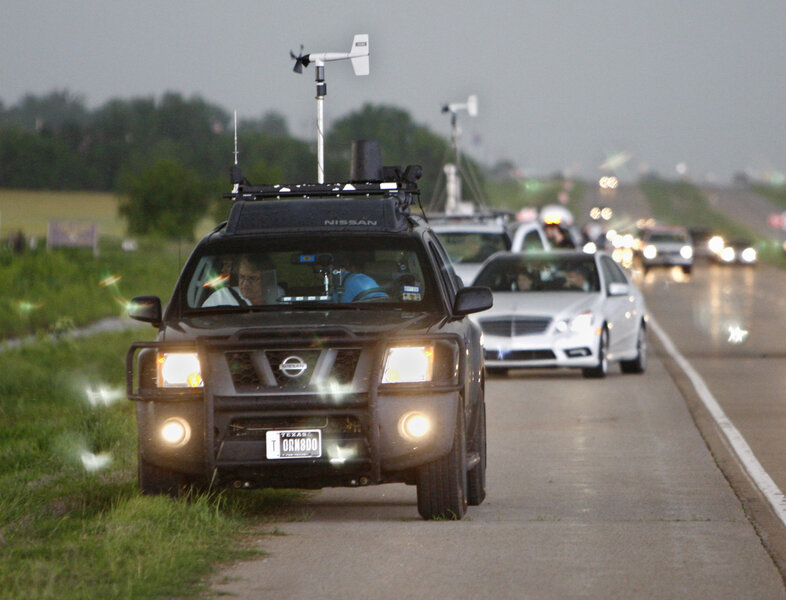3 storm chasers killed in Texas. Are spotters still important for science?
Loading...
Three storm chasers died on Tuesday when their cars collided at a crossroad in a remote part of northwestern Texas, as they pursued a tornado that had triggered warnings from the National Weather Service in Lubbock.
Kelley Williamson and Randy Yarnall, traveling together in one of the cars, were Cassville, Mo.-based contractors for The Weather Channel and stars of that network’s show “Storm Wranglers” who often aired live streams of storms as they tracked them. In the other car was Corbin Jaeger, of Peoria, Ariz., who had documented storms since 2014 for the site MadWx, which features live streams and other media of tornadoes.
Investigators told the Lubbock Avalanche-Journal they believed the black Suburban carrying Mr. Williamson and Mr. Yarnall likely ran a stop sign before colliding with the Jeep piloted by Mr. Jaeger, at the intersection outside of the town of Spur, in Dickens County. All three were killed on impact.
In a statement, the Weather Channel expressed regret for the deaths of Williamson and Yarnall, calling them “beloved members of the weather community.”
“We are saddened by this loss and our deepest sympathies go out to the families and loved ones of all involved,” it said.
The tragedy is likely to turn a light back onto the dangers inherent to storm chasing – a practice that has become associated, in recent decades, with thrill-seekers – and perhaps raise questions about the value of spotting for sport. Yet some storm chasers say the practice retains real value for science and the public alike, both as a real-time aid for storm authorities and a longer-term source for storm data.
Storm spotting as a public service in the United States originated during World War II, when the military began collaborating with the Weather Bureau to set up volunteer networks near potentially vulnerable military sites, like defense installations and ammunition dumps, according to a 1998 paper by three NOAA researchers. And with the proliferation of film and other media, volunteer spotting – especially for tornadoes – blossomed.
Then came “Twister.”
The 1996 blockbuster film was based partly on the pioneering VORTEX projects of 1994 and 1995 that gathered data on supercells (the powerful and long-lasting thunderstorms sometimes associated with tornadoes) and gave a lift to the National Weather Service’s tornado-warning system, according to OurAmazingPlanet. The movie’s success generated a flood of interest in meteorology, with enrollments ballooning at newly created university departments and tour guides signing up adrenaline-junkie clients. But some scientists lamented the rise of a post-“Twister” culture of storm chasing that elevated sensationalism over safety.
"The storm-chase culture has blown meteorology off-course,” wrote John Knox, atmospheric sciences professor at the University of Georgia, in a 2013 USA Today editorial.
"No more shell-game arguments of 'It's the bad chasers who are to blame.' Even the best admit that they get too close sometimes," he added.
"No more shifting rationales for storm chasing, from scientific research (where are the data sets?) to increased warning times (how much do chasers add to warning times – where's the peer-reviewed study?) to lives saved (how many chasers are trained and up-to-date in CPR and first aid?) to educational benefit (prove it with peer-reviewed educational research)."
Still, chasers’ deaths are rare. The three killed in Tuesday's car crash were the first fatalities since in 2013, when an amateur and three scientists were killed in Oklahoma.
And some scientists are more positive about the amateurs.
Howard Bluestein, a meteorologist at the University of Oklahoma, says he and a National Science Foundation-funded group of students bring Doppler radars into the field “to catch tornadoes in the act of forming, to learn about why some storms produce tornadoes and some don’t,” and to gather information on tornadoes’ structures.
"Some days when we’re out there, we have trouble finding a parking spot for our truck. That’s very annoying,” he tells The Christian Science Monitor. And some chasers, he says, do drive carelessly. But amateurs who text or call into the National Weather Service when they see a tornado often give them a leg up on issuing warnings.
“Warning based on radar is not 100 percent foolproof, so we need to have someone there seeing what’s happening,” he says.
Scientists have a growing toolkit at their disposal: Doppler radar shows them where there might be a vortex and how a tornado is moving, and computer models are increasingly accurate in predicting the location of a potential tornado-producing storm. And in situ readings of ground temperatures taken by Dr. Bluestein and other meteorologists can help predict whether a twister will make an appearance. But the footage and photographs fished up from amateur networks by his students, he tells the Monitor, can act as a visual complement to their measurements.
“People out doing scientific research can’t be everywhere at the same time,” he says. "When there are a lot of people out there, the probability is high that someone will actually get photos of the phenomenon, and you can compare what chasers are seeing with what you're seeing on Doppler radar."








